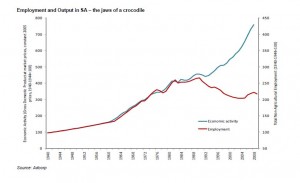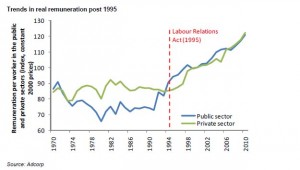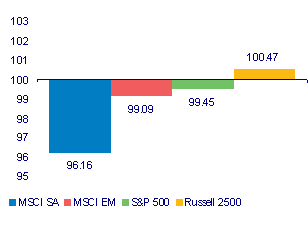Economic activity in SA expanded in June, but according to our Hard Number Index of Economic Activity (HNI) the pace of growth may well have slowed marginally rather than picked up momentum.
Our HNI attaches equal weights to two very up to date hard numbers, namely new vehicle sales for June, as released by NAAMSA, and the size of the note issue as at the end of June. The HNI may be compared to the Coinciding Indicator of the SA Business Cycle calculated by the SA Reserve Bank. This indicator, with a very similar lower turning point for the current cycle, is however only updated to March 2011, leaving it well behind current economic events.
Vehicle sales began a very strong recovery in late 2009. Sales of all new vehicles were particularly strong in March 2011. Actual sales that month were 53 478 units, which, since March is usually a very good month for vehicle sales, translated into a seasonally adjusted 50 101 units. Since March 2011 vehicle sales have fallen back significantly from these levels, though sales in June were modestly up on those of May. On a seasonally adjusted basis sales had fallen from the over 50 000 units sold in March to 43 108 units sold in May and recovered to 44 359 units sold in June 2011. The vehicle sales growth cycle appears to have declined significantly with the current annual growth trend around the 10% annual rate, perhaps to recede further.
We have mentioned before that the Combined Motor Holdings (CMH) share price has consistently provided a very good, even leading, indicator of the state of the new vehicle market. This relationship appears to be holding up with the CMH share price having peaked late last year, consistent with the peak in the new vehicle cycle.
While the news about vehicle sales may be regarded as somewhat less encouraging about the current state of the SA economy, the demand for and supply of notes in June is somewhat more encouraging. The Reserve Bank, when it issues notes, satisfies the extra demands of the public for notes, presumably to spend, and from the banks for cash reserves, presumably so that they are able to lend more. Banks in SA do not hold excess cash reserves of any magnitude and so the supply of notes, adjusted for cash reserve requirements, is equivalent to the money base of the system, adjusted for cash reserve requirements, or what is also described as high powered money. This makes the note issue a reliable coinciding indicator of economic activity, with the great advantage of being a highly up to date indicator.
The growth in supply of notes to the economy slowed down consistently between early 2009 and early 2011. This growth cycle appears to have picked up momentum recently. The slower growth in the supply of notes, until recently, was however offset by lower inflation, providing scope for acceleration in the growth in the real supply of notes. This growth was necessary to sustain the economic recovery under way. Now a mixture of slightly higher inflation and slightly faster growth in the note issue has helped stabilise the real money base cycle at about a four per cent rate.
If the economy is to sustain a growth rate that is still below its potential or sustainable rate, a further increase in the rate of growth in the demands for cash, well ahead of inflation is called for. No help in this regard can be expected from lower interest rates. SA does not (alas) engage in money supply targeting or quantitative easing. However it may be hoped that any increase in short term interest rates will be postponed until the demands for and supply of bank credit and the demands for the banks and the public for more cash indicate a clear case for tightening. The case for tightening based on the most recent money supply and credit numbers remains, a very week one. Faster growth in the supply of narrow money, broad money and bank credit deserves encouragement.
To view the graphs and tables referred to in the article, see Daily Ideas in the Daily View:Daily View 13 July



